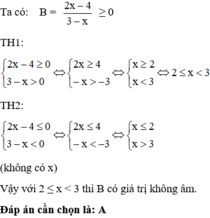

Hãy nhập câu hỏi của bạn vào đây, nếu là tài khoản VIP, bạn sẽ được ưu tiên trả lời.



a, Vì \(2+\frac{3-2x}{5}\)không nhỏ hơn \(\frac{x+3}{4}-x\)
\(\Rightarrow2+\frac{3-2x}{5}\ge\frac{x+3}{4}-x\)
Giải phương trình :
\(2+\frac{3-2x}{5}\ge\frac{x+3}{4}-x\)
\(\Rightarrow\frac{40}{20}+\frac{4\left(3-2x\right)}{20}\ge\frac{5\left(x-3\right)}{20}-\frac{20x}{20}\)
\(\Rightarrow40+12-8x\ge5x-15-20x\)
\(\Rightarrow7x=67\)
\(\Rightarrow x\ge\frac{67}{7}\)
b, \(\frac{2x+1}{6}-\frac{x-2}{9}>-3\)
\(\Rightarrow\frac{3\left(2x+1\right)}{18}-\frac{2\left(x-2\right)}{18}>\frac{-54}{18}\)
\(\Rightarrow6x+3-2x+4>-54\)
\(\Rightarrow4x>-61\)
\(\Rightarrow x>\frac{-61}{4}\)\(\left(1\right)\)
Và : \(x-\frac{x-3}{4}\ge3-\frac{x-3}{12}\)
\(\frac{12x}{12}-\frac{3\left(x-3\right)}{12}\ge\frac{36}{12}-\frac{x-3}{12}\)
\(\Rightarrow12x-3x+9\ge36-x+3\)
\(\Rightarrow10x\ge30\)
\(\Rightarrow x\ge3\)\(\left(2\right)\)
Từ \(\left(1\right)\)và \(\left(2\right)\)\(\Rightarrow\hept{\begin{cases}x>\frac{-61}{4}\\x\ge3\end{cases}\Rightarrow x>3}\)
Vậy với giá trị x > 3 thì x là nghiệm chung của cả 2 bất phương trình

bài1 A=\(\left(\frac{3-x}{x+3}\cdot\frac{x^2+6x+9}{x^2-9}+\frac{x}{x+3}\right):\frac{3x^2}{x+3}\)
=\(\left(-\frac{x-3\cdot\left(x+3\right)^2}{\left(x+3\right)^2\cdot\left(x-3\right)}+\frac{x}{x+3}\right):\frac{3x^2}{x+3}\)
=\(-\frac{x}{x+3}\cdot\frac{x+3}{3x^2}=\frac{-1}{3x}\)
b) thế \(x=-\frac{1}{2}\)vào biểu thức A
\(-\frac{1}{3\cdot\left(-\frac{1}{2}\right)}=\frac{2}{3}\)
c) A=\(-\frac{1}{3x}< 0\)
VÌ (-1) <0 nên 3x>0
x >0

a) \(ĐKXĐ:\hept{\begin{cases}x\ne0\\x\ne-3\\x\ne3\end{cases}}\)
\(A=\left(\frac{1}{3}+\frac{3}{x^2-3x}\right):\left(\frac{x^2}{27-3x^2}+\frac{1}{x+3}\right)\)\(=\left[\frac{1}{3}+\frac{3}{x\left(x-3\right)}\right]:\left(\frac{-x^2}{3x^2-27}+\frac{1}{x+3}\right)\)
\(=\left[\frac{x\left(x-3\right)}{3x\left(x-3\right)}+\frac{9}{3x\left(x-3\right)}\right]:\left[\frac{-x^2}{3\left(x^2-9\right)}+\frac{1}{x+3}\right]\)
\(=\frac{x^2-3x+9}{3x\left(x-3\right)}:[\frac{-x^2}{3\left(x-3\right)\left(x+3\right)}+\frac{3\left(x-3\right)}{3\left(x-3\right)\left(x+3\right)}]\)
\(=\frac{x^2-3x+9}{3x\left(x-3\right)}:\frac{-x^2+3x-9}{3\left(x-3\right)\left(x+3\right)}\)\(=\frac{x^2-3x+9}{3x\left(x-3\right)}.\frac{3\left(x-3\right)\left(x+3\right)}{-\left(x^2-3x+9\right)}=\frac{x+3}{-x}=\frac{-x-3}{x}=-1-\frac{3}{x}\)
b) \(A< -1\)\(\Leftrightarrow-1-\frac{3}{x}< -1\)\(\Leftrightarrow\frac{-3}{x}< 0\)
mà \(-3< 0\)\(\Rightarrow x>0\)và \(x\ne3\)
Vậy \(A< -1\Leftrightarrow\hept{\begin{cases}x>0\\x\ne3\end{cases}}\)
c) Vì \(-1\inℤ\)\(\Rightarrow\)Để A nguyên thì \(\frac{3}{x}\inℤ\)\(\Rightarrow3⋮x\)
\(\Rightarrow x\inƯ\left(3\right)=\left\{\pm1;\pm3\right\}\)
So sánh với ĐKXĐ \(\Rightarrow x=\pm3\)loại
Vậy A nguyên \(\Leftrightarrow x=\pm1\)

a) Đk: x > 0 và x khác +-1
Ta có: A = \(\left(\frac{x+1}{x}-\frac{1}{1-x}-\frac{x^2-2}{x^2-x}\right):\frac{x^2+x}{x^2-2x+1}\)
A = \(\left[\frac{\left(x-1\right)\left(x+1\right)+x-x^2+2}{x\left(x-1\right)}\right]:\frac{x\left(x+1\right)}{\left(x-1\right)^2}\)
A = \(\frac{x^2-1+x-x^2+2}{x\left(x-1\right)}\cdot\frac{\left(x-1\right)^2}{x\left(x+1\right)}\)
A = \(\frac{x+1}{x}\cdot\frac{x-1}{x\left(x+1\right)}=\frac{x-1}{x^2}\)
b) Ta có: A = \(\frac{x-1}{x^2}=\frac{1}{x}-\frac{1}{x^2}=-\left(\frac{1}{x^2}-\frac{1}{x}+\frac{1}{4}\right)+\frac{1}{4}=-\left(\frac{1}{x}-\frac{1}{2}\right)^2+\frac{1}{4}\le\frac{1}{4}\forall x\)
Dấu "=" xảy ra <=> 1/x - 1/2 = 0 <=> x = 2 (tm)
Vậy MaxA = 1/4 <=> x = 2

a) B xác định\(\Leftrightarrow\hept{\begin{cases}x+1\ne0\\x-1\ne0\end{cases}}\Rightarrow x\ne\pm1\)
b) \(x^2-x=0\Leftrightarrow x\left(x-1\right)=0\)
\(\Leftrightarrow\orbr{\begin{cases}x=0\\x-1=0\end{cases}}\Leftrightarrow\orbr{\begin{cases}x=0\\x=1\end{cases}}\)
Mà x khác 1 nên x = 0
\(B=\frac{x-1}{x+1}-\frac{x+1}{x-1}-\frac{4}{1-x^2}\)
\(=\frac{\left(x-1\right)^2-\left(x+1\right)^2}{\left(x+1\right)\left(x-1\right)}+\frac{4}{x^2-1}\)
\(=\frac{x^2-2x+1-x^2-2x-1}{\left(x+1\right)\left(x-1\right)}+\frac{4}{x^2-1}\)
\(=\frac{-4x}{\left(x+1\right)\left(x-1\right)}+\frac{4}{\left(x+1\right)\left(x-1\right)}\)
\(=\frac{-4x+4}{\left(x+1\right)\left(x-1\right)}=\frac{-4\left(x-1\right)}{\left(x+1\right)\left(x-1\right)}=\frac{-4}{x+1}\)
Thay x = 0 vào B, ta được \(P=\frac{-4}{0+1}=-4\)
Vậy P = -4 khi \(x^2-x=0\)
c) \(B=-3\Leftrightarrow\frac{-4}{x+1}=-3\Leftrightarrow x+1=\frac{4}{3}\)
\(\Leftrightarrow x=\frac{1}{3}\)
Vậy B = -3 khi \(x=\frac{1}{3}\)
d) \(B< 0\Leftrightarrow\frac{-4}{x+1}< 0\Leftrightarrow x+1>0\Leftrightarrow x>-1\)
Vậy x > - 1 thì B < 0
tích cho cậu là ấn vào link hay là thích

Ta có (a + b + c)2 \(\ge0\forall a;b;c\inℝ\)
=> a2 + b2 + c2 + 2ab + 2bc + 2ca \(\ge\)0
=> a2 + b2 + c2 \(\ge\)0 - (2ab + 2bc + 2ca)
=> a2 + b2 + c2 \(\le\)2ab + 2bc + 2ca
=> a2 + b2 + c2 \(\le\)2(ab + bc + ca)
Dấu "=" xảy ra <=> a + b + c = 0
Xí bài 2 ý a) trước :>
4x2 + 2y2 + 2z2 - 4xy - 4xz + 2yz - 6y - 10z + 34 = 0
<=> ( 4x2 - 4xy + y2 - 4xz + 2yz + z2 ) + ( y2 - 6y + 9 ) + ( z2 - 10z + 25 ) = 0
<=> [ ( 4x2 - 4xy + y2 ) - 2( 2x - y )z + z2 ] + ( y - 3 )2 + ( z - 5 )2 = 0
<=> [ ( 2x - y )2 - 2( 2x - y )z + z2 ] + ( y - 3 )2 + ( z - 5 )2 = 0
<=> ( 2x - y - z )2 + ( y - 3 )2 + ( z - 5 )2 = 0
Ta có : \(\hept{\begin{cases}\left(2x-y-z\right)^2\\\left(y-3\right)^2\\\left(z-5\right)^2\end{cases}}\ge0\forall x,y,z\Rightarrow\left(2x-y-z\right)^2+\left(y-3\right)^2+\left(z-5\right)^2\ge0\)
Dấu "=" xảy ra <=> \(\hept{\begin{cases}2x-y-z=0\\y-3=0\\z-5=0\end{cases}}\Leftrightarrow\hept{\begin{cases}x=4\\y=3\\z=5\end{cases}}\)
Thế vào T ta được :
\(T=\left(4-4\right)^{2014}+\left(3-4\right)^{2014}+\left(5-4\right)^{2014}\)
\(T=0+1+1=2\)

a) Phân thức xác định được \(\Leftrightarrow\hept{\begin{cases}2x+10\ne0\\x\ne0\\2x\left(x+5\right)\ne0\end{cases}}\)\(\Leftrightarrow\hept{\begin{cases}x\ne0\\x+5\ne0\end{cases}}\)
Vậy...
b) \(P=\frac{x^2+2x}{2x+10}+\frac{x-5}{x}+\frac{50-5x}{2x\left(x+5\right)}\)
=> \(P=\frac{x\left(x^2+2x\right)+2\left(x-5\right)\left(x+5\right)+50-5x}{2x\left(x+5\right)}\)
=> \(P=\frac{x^3+2x^2+2x^2-50+50-5x}{2x\left(x+5\right)}\)
=> \(P=\frac{x^3+4x^2-5x}{2x\left(x+5\right)}=\frac{x\left(x-1\right)\left(x+5\right)}{2x\left(x+5\right)}=\frac{\left(x-1\right)}{2}\)
\(P=0\Leftrightarrow x-1=0\Leftrightarrow x=1\)